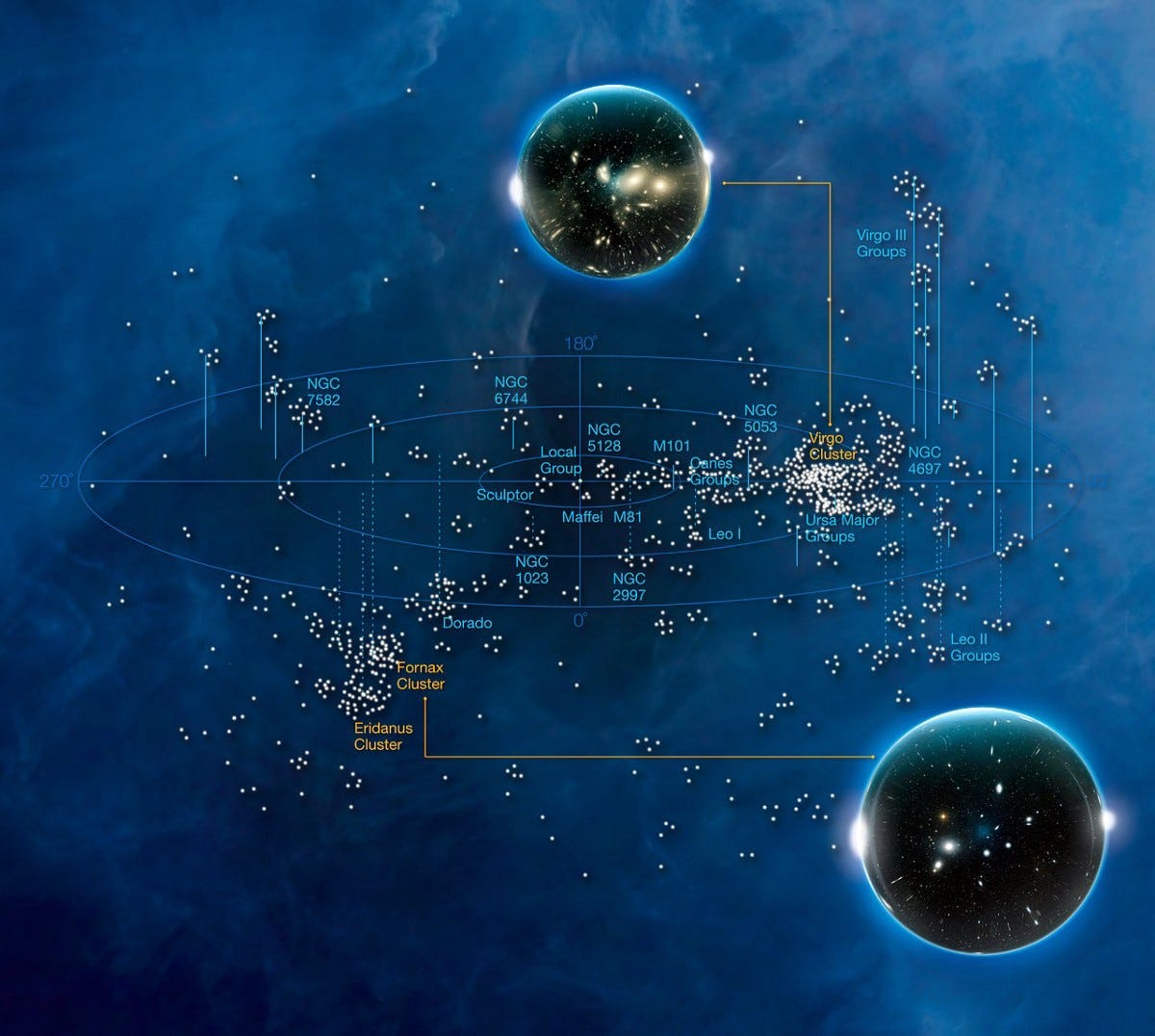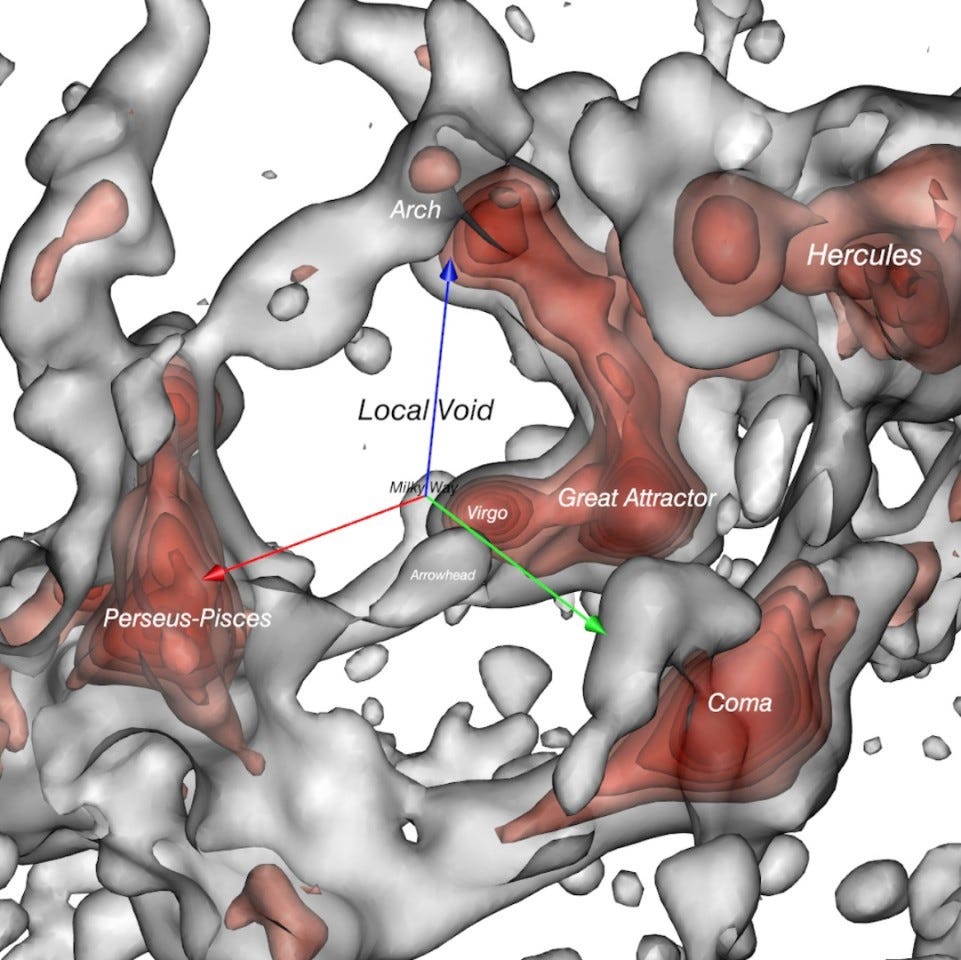Visions of the Cosmic Web
Why the largest thing in the Universe has been almost invisible to us, until now.
The history of astronomy is the story of our own fading self importance. We once placed ourselves at the centre of creation, presuming that everything revolved around the Earth. Over centuries that conceit has been challenged over and over again.
We can no longer place the Earth at the centre of anything. Astronomers have revealed the Universe to be far larger than anyone could have imagined; indeed far larger than any of us can reasonably imagine even now. The scale of the structures we have found - galaxies, clusters and superclusters - make our small world look insignificant.
Now astronomers are shedding light on an even bigger structure, one that may have shaped the cosmos for billions of years. Much of this research has been done through computer models, but more advanced telescopes, including the ELT discussed below, are starting to reveal the strands of this enormous cosmic web.
The Atacama Desert — the driest, most arid place on Earth — may seem an unlikely place to find a building site. But here, on an isolated mountain far from civilization, something strange is rising from the dusty desert sands. This is the ELT — the Extremely Large Telescope — the most powerful eye on the heavens ever constructed.

The strength of its vision is hard to grasp. For the first time we will be able to directly see planets around other stars and pick out individual stars in distant galaxies. Astronomers will observe the edge of the Universe, peering back billions of years to watch the birth of the galaxies and the first stars. But, somewhat paradoxically, its intense gaze will also reveal the largest structure of the Universe, one that has been almost invisible to us until recently.
For most of history astronomers had no idea of the true scale of creation. Though the night sky might appear crowded, especially if you visit somewhere as remote as the Atacama Desert, most of the stars you can see are only a few thousand light years away. If you are lucky you might spot Andromeda, a faint smudge in the northern sky. If you do — congratulations — you are seeing the most distant object visible to the human eye.
That distance, two point five million light years, might seem inconceivably far. But then remember that the Universe is at least ninety billion light years across, and probably more. What we can see, at least with our eyes, is no more than a speck of dust in the great vastness of creation.
The Andromeda Galaxy is not just the furthest thing we can see, it is also the biggest. Andromeda is probably, though we aren’t sure, a bit bigger than our own Milky Way. And though a few dozen other galaxies are visible from Earth — most spectacular are the Magellanic Clouds of the southern hemisphere — Andromeda is the largest one within a few million light years.
There are two things that block us from seeing bigger objects. The first is the structure of the Milky Way. Our solar system lies on one side of the galaxy, roughly 25,000 light years from the middle. The centre of the galaxy — a dense crowd of stars and dust — is visible as silvery cloud stretching across the night sky. Though beautiful, the galactic centre blocks our view, meaning we have little idea of what lies on the other side of the galaxy.
The second is our position inside larger structures. Just as we cannot see the shape of our own galaxy — astronomers have deduced, after much effort, that it has a spiral structure — we cannot see the shape of the larger group of galaxies that we belong to. But even though we cannot easily see them, rest assured that these larger structures do exist.
All the galaxies that can be seen with the naked eye belong to the Local Group. Andromeda and the Milky Way dominate the group, but it holds at least eighty other, smaller, galaxies. Many of these galaxies interact with our own — orbiting it, or even colliding or merging with the Milky Way.
Billions of years from now astronomers think that the Milky Way and Andromeda will collide and merge into a single galaxy. Over even longer periods of time the Local Group will probably coalesce into a single giant galaxy. This process — of galactic collisions and mergers — is not as violent as it sounds. Stars rarely collide, even when galaxies do, and the disturbances can instead trigger waves of star birth across the galaxy.
The Local Group, like other galaxy groups, is not easy to see, even with telescopes. The first hints of their existence did not come until the late 1950s when astronomers completed detailed maps of the night sky. George Abell — an American astronomer — noticed that the galaxies were not evenly spread, as one might expect. Instead they seem to cluster in space, forming groups of galaxies surrounded by voids.

Further analysis revealed even larger patterns. The galaxy groups themselves are organised, forming superclusters. Astronomers discovered that the Local Group was a member of the Virgo cluster. That too turned out to be a member of a bigger structure : the Laniakea Supercluster. That supercluster is genuinely enormous — holding more than one hundred thousand galaxies, and countless trillions of stars.
When astronomers mapped Laniakea in 2004, they found that our galaxy sits on an outer fringe of the supercluster. But they also discovered that Laniakea is falling apart. The structure, more than five hundred million light years across, seems to lack the gravitational strength to hold itself together. Over time its clusters and galaxies will drift apart, and eventually recombine to form new superclusters.
On the largest scale, then, these structures may be no more than temporary illusions visible to astronomers. But their presence, however impermanent it may be, implies the existence of their reverse. These are the voids, vast regions of space in which very little exists. Stretching for hundreds of millions of light years, these empty places almost seem to repel matter.
Any galaxy unlucky enough to find itself within a void tends to flee at high speed. Gravity is the reason — matter loves matter, and superclusters have a lot of matter. They exert a constant powerful pull on the rest of the Universe. Any unbound matter — such as a galaxy lost in a void — accelerates towards the nearest cluster.
The clusters and superclusters form a network across the cosmos, merging into even larger structures. These are the sheets, walls and filaments of the Universe. When astronomers map the Universe on this large scale these supermassive structures form a web like pattern, which astronomers have nicknamed the Cosmic Web.
Once astronomers realised the existence of the Cosmic Web, they started finding the structures that form it. One, nicknamed the Great Attractor, is pulling our supercluster towards it with enormous strength. So much strength, in fact, that it seems to be temporarily overcoming the expansion of the Universe. Other gigantic structures — the Great Wall, 750 million light years long; the Perseus-Pegasus Filament, more than one billion light years across — are amongst the largest objects known in creation.
But even as astronomers found these structures, questions started arising. How could such enormous structures form? Was it really only gravity that sculpted the shape of the Universe? And how did dark matter fit in to the whole arrangement?

Astronomers turned to computers to answer these questions. They built computer models, some — like the Illustris Project — so ambitious that they tried to simulate the entire history of the Universe. But in these models they found hints of how, exactly, the Universe took shape.
As you might imagine, simulating the entire Universe takes a supercomputer. The Illustris Project used two computers — in Germany and France — and produced hundreds of terabytes of data. In 2014, after wading through all that data, astronomers found what they were looking for. The model could reproduce the real Universe in crucial ways. Galaxies and clusters appeared in the simulation as they did in reality.
The simulation found that dark matter was crucial to both the formation of galaxies and the Cosmic Web. According to the model, shortly after the Big Bang dark matter collected in threads stretching across the Universe. Over time, with the help of gravity, these threads gathered into ever denser strings.
Where dark matter gathered, so too did normal, visible matter. These threads formed the seeds of galaxies, distributing them along the filaments and walls that we now observe in the Cosmic Web. In the spaces between the threads the Universe remained mostly empty. Without dark matter, normal matter was too thinly spread to ignite stars or galaxies. These empty spaces evolved into the voids that we see today.
Although the true nature of dark matter is still unknown, models like the Illustris Project are strong evidence for its existence. Indeed, that evidence is now so strong that astronomers are all but certain dark matter really exists. Rival theories — which try to explain the Universe without invoking dark matter — have so far all fallen at the hurdle of explaining the presence of the Cosmic Web.
Astronomers are still continuing the task of mapping out the Web, finding new large structures around us. In July 2020 a team at the University of Hawaii announced the discovery of the South Pole Wall. This — a massive filament stretching more than 1.3 billion light years — is home to vast numbers of galaxies, and is the largest thing ever discovered.
The next generation of telescopes, starting with the ELT, will help cast even more light on these enormous structures. In doing so, astronomers hope to learn ever more about how the Universe came to be. The Atacama Desert may indeed be a strange place to find a building site, but even stranger discoveries may soon emerge from those desert sands.


